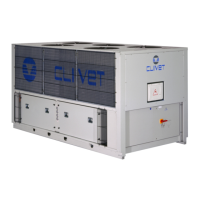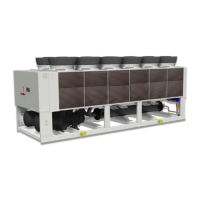Do you have a question about the CLIVET WDH-3 2.160 and is the answer not in the manual?
Details the serial number label, its placement, and the importance of the serial number for identification.
Guidelines for manual use, expert personnel, local regulations, intended use, and product certifications.
Procedures for maintenance, periodic inspections, fault response, and authorized repairs.
Identifies danger zones, provides handling instructions, and outlines installation risks.
Details hazards associated with electrical systems, refrigerant, and water circuits.
Provides specific safety information for refrigerants and warns about risks from moving parts.
Steps for unit inspection upon reception, storage recommendations, and safe handling.
Instructions for safe hoisting, packing removal, and general unit positioning.
Guidance on unit installation, clearances, and installing anti-vibration devices.
Details on piping, valves, filters, flow switches, and freeze protection for water connections.
Illustrates recommended user-side water connections and source side connection schematics.
Guidance on source side filters, flow control, antifreeze solutions, and temperature probes.
Requirements for electrical installation, conformity with regulations, and data line guidelines.
Procedures for connecting the unit to mains power and using remote control features.
Functionality of external temperature/humidity probes and water reset for set-point correction.
Overview of the modular system components and their communication protocol.
Details on unit networking, CAN converters, and Modbus conversion via RS 485.
Comprehensive steps for unit startup, including system checks and parameter verification.
Monitoring key operational parameters like water flow rates and refrigerant circuit data.
Explains the control panel, thermal regulation logic, and set-point compensation methods.
Overview of accessible parameters, menu structure, and configuration details.
Instructions for using the keypad to navigate setup menus and configure parameters.
Diagram showing the structure for visualizing unit system status and indicators.
Detailed status information for compressor, evaporator, and other unit modules.
Procedures for viewing, storing, and deleting alarms, with safety notes.
Lists alarm codes and descriptions for central, compressor, pump, and evaporator modules.
Procedures for cleaning the water exchanger and checking the unit's structural integrity.
Guidelines for periodic maintenance inspections and information on the PED directive.
Recommendations for safely putting the unit at rest and preparing for restart after inactivity.
Tables providing data for testing refrigerant circuit operation via overheating and subcooling.
Guidance on diagnosing and resolving high/low pressure alarms and faulty probes/transducers.
Troubleshooting common causes for compressor protection alarms and related issues.
Technical data for cooling, heating, compressors, and heat exchangers.
Factors for antifreeze, fouling corrections, and calibration set points for control devices.
Sound power and pressure levels for standard and low-noise units across different classes.
Diagrams and dimensional data for all acoustic configurations and efficiency classes.
Details the serial number label, its placement, and the importance of the serial number for identification.
Guidelines for manual use, expert personnel, local regulations, intended use, and product certifications.
Procedures for maintenance, periodic inspections, fault response, and authorized repairs.
Identifies danger zones, provides handling instructions, and outlines installation risks.
Details hazards associated with electrical systems, refrigerant, and water circuits.
Provides specific safety information for refrigerants and warns about risks from moving parts.
Steps for unit inspection upon reception, storage recommendations, and safe handling.
Instructions for safe hoisting, packing removal, and general unit positioning.
Guidance on unit installation, clearances, and installing anti-vibration devices.
Details on piping, valves, filters, flow switches, and freeze protection for water connections.
Illustrates recommended user-side water connections and source side connection schematics.
Guidance on source side filters, flow control, antifreeze solutions, and temperature probes.
Requirements for electrical installation, conformity with regulations, and data line guidelines.
Procedures for connecting the unit to mains power and using remote control features.
Functionality of external temperature/humidity probes and water reset for set-point correction.
Overview of the modular system components and their communication protocol.
Details on unit networking, CAN converters, and Modbus conversion via RS 485.
Comprehensive steps for unit startup, including system checks and parameter verification.
Monitoring key operational parameters like water flow rates and refrigerant circuit data.
Explains the control panel, thermal regulation logic, and set-point compensation methods.
Overview of accessible parameters, menu structure, and configuration details.
Instructions for using the keypad to navigate setup menus and configure parameters.
Diagram showing the structure for visualizing unit system status and indicators.
Detailed status information for compressor, evaporator, and other unit modules.
Procedures for viewing, storing, and deleting alarms, with safety notes.
Lists alarm codes and descriptions for central, compressor, pump, and evaporator modules.
Procedures for cleaning the water exchanger and checking the unit's structural integrity.
Guidelines for periodic maintenance inspections and information on the PED directive.
Recommendations for safely putting the unit at rest and preparing for restart after inactivity.
Tables providing data for testing refrigerant circuit operation via overheating and subcooling.
Guidance on diagnosing and resolving high/low pressure alarms and faulty probes/transducers.
Troubleshooting common causes for compressor protection alarms and related issues.
Technical data for cooling, heating, compressors, and heat exchangers.
Factors for antifreeze, fouling corrections, and calibration set points for control devices.
Sound power and pressure levels for standard and low-noise units across different classes.
Diagrams and dimensional data for all acoustic configurations and efficiency classes.











